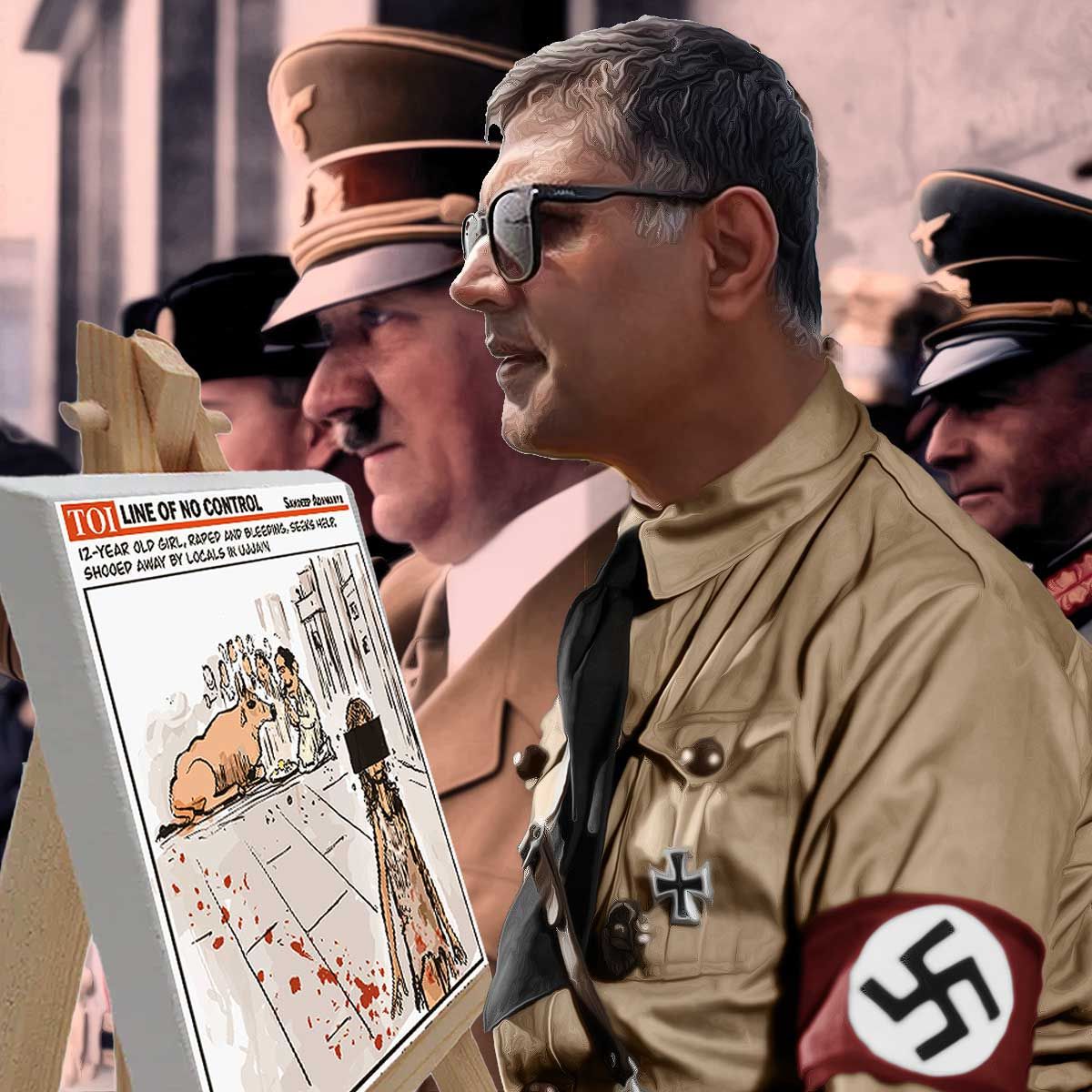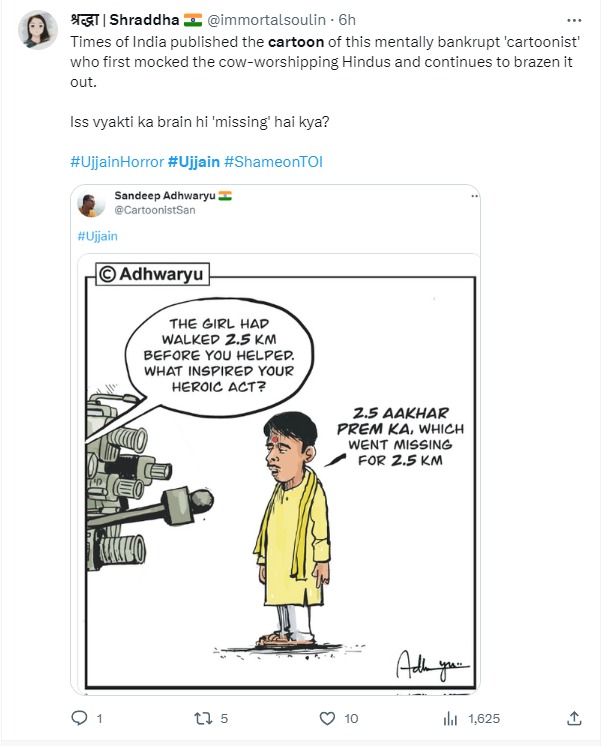More Coverage
Twitter Coverage
Satyaagrah
Written on
Satyaagrah
Written on
Satyaagrah
Written on
Satyaagrah
Written on
Satyaagrah
Written on
JOIN SATYAAGRAH SOCIAL MEDIA
"Sketching prejudice, erasing truths": Deciphering TOI’s Sandeep Adhwaryu's Ujjain cartoon - A masterclass in CIA-style propaganda or mere artistic expression? Venturing into the thin line between art and Hinduphobic indoctrination in modern media

Throughout history, art has been both a reflection of society and a tool for influencing it. This is a tale not just about conspiracy theories and whispers but one that uncovers the role of art as a pawn in the larger game of geopolitical chess. And while many of us associate conspiracy theories with unsolved mysteries or unsubstantiated claims, there are times when they unfurl to reveal startling truths. A classic adage, ‘there is no smoke without fire’, stands the test of time, reminding us that behind every whisper, there could be a roaring truth.
Perhaps one of the most intriguing revelations in this realm was the discovery of the CIA’s clandestine involvement in promoting American Abstract Expressionist painting during the Cold War. What for? Propaganda. A well-documented report from The Independent illuminates this astonishing strategy. Renowned American artists, the likes of Jackson Pollock, Robert Motherwell, Willem de Kooning, and Mark Rothko, found their works being wielded as covert weapons against communism. And this, during an era when modern art itself was a subject of skepticism within American society.
Contrast this with the art from Russia of the same period: blatant, brimming with communist ideologies, unapologetically thrusting propaganda into the public eye. The CIA's approach, however, was more nuanced. Their utilization of modern art was not just about sending political messages but projecting an image of America as a bastion of freedom, intellect, and cultural prowess. The so-called ‘Long Leash’ program was not merely about championing art but was an intricate ploy to subtly counteract the enchanting promises of communism, which on the surface heralded love, justice, and equality.
|
The Thin Veil of Hinduphobia
Drawing parallels to contemporary times, one can't help but notice the insidious undertones in modern representations as well. Take the cartoon on the Ujjain case by TOI’s Sandeep Adhwaryu. To the unsuspecting eye, it may seem like a mere satirical take. But for those attuned to the nuances, it's an embodiment of what can only be termed as 'Hitler-esque Hinduphobia'. Just as art was once used to fight the ideological battles of the Cold War, today, it's being employed, albeit more overtly, to foster stereotypes and propagate biased narratives.
Conspiracy theories have long been dismissed as fabrications of the overly imaginative. However, the phrase "There's no smoke without fire" seems apt when one examines the CIA's covert use of American Abstract Expressionist art as Cold War propaganda. This art, representative of artists like Jackson Pollock and Mark Rothko, conveyed the freedom and intellectualism that the USA wished to broadcast, contrasting heavily with Russia's overtly propagandistic art.
But the tale gets even more fascinating. CIA agent Donald Jameson once jovially remarked about how wonderful it would be if people believed that the CIA was behind Abstract Expressionism. His words, while lighthearted, held undertones of a profound strategy. He highlighted how Abstract Expressionism, by its free nature, made the structured and rigid Socialist Realism appear even more confined. The CIA cleverly exploited this difference in various exhibitions.
Jameson went on to describe the agency's subtle dealings. They ensured that artists under their influence never appeared too close to the CIA. Paradoxically, if an artist was perceived to be leaning towards Moscow's ideology, it strengthened the impact of the 'Long Leash' program. This led to the creation of the Congress for Cultural Freedom, a sprawling network of artists and intellectuals, some unsuspecting, working under the CIA's directives. The CIA's web of control extended not just over this organization but also the venues where the art was displayed. Yet, this covert operation remained hidden for a long time.
|
Art, often seen as a mirror to society, sometimes hides more than it reveals. It can be a conduit for political, religious, or ideological propaganda, a tool for those who support or commission it. The Renaissance art of Italy, renowned worldwide, also bore the imprints of the religious and political realities of its time.
The mastery with which institutions, be it the CIA or the Italian clergy, have harnessed art to shape perceptions and further agendas, prompts a re-evaluation. How much of what we see is genuine artistic expression, and how much is meticulously planned propaganda?
It's often remarked that art is the mirror of society. Indeed, throughout history, art has been a medium to depict, critique, and reflect upon the socio-political realities of the times. However, what's often overlooked is how this very art, when employed as a tool, can shape, sway, and oftentimes, manipulate public opinion.
Propaganda doesn’t inherently denote evil. For centuries, art has been a mode to depict religious fervour or political ambitions. Churches were adorned with frescoes that spoke of religious stories, aiming to inspire faith. Political murals, on the other hand, painted the ideologies of those in power, with the purpose of consolidating their rule. But it is the intent and the aftermath of such representations that are crucial. When does the representation cross over into the territory of manipulation?
One of the darkest periods in history, the reign of Hitler, provides a chilling testimony to this. The Third Reich masterfully used art as a weapon. “Is propaganda, as we understand it, not also a form of art?” questioned Joseph Goebbels, the man who helmed the Nazi propaganda machinery. The insidiousness of Nazi propaganda can’t be understated. Art, in its many forms - from films to cartoons and posters, was wielded to embed anti-Semitic sentiments within the German psyche. The recurrent theme was to paint Jews as the 'other' – a menace that threatened the pure Aryan bloodline.
|
This wasn't an isolated occurrence in history. The strategy of using art for propaganda isn’t exclusive to the Nazis; it has its roots in Communist and Socialist ideologies. The aim remains consistent: manipulate the narrative to achieve political or ideological goals.
However, as times change, and as art mediums evolve, it becomes ever more important for the viewers to not just consume but critically analyze. The line between art and manipulation can often be thin, and it's crucial for society to recognize when it's being unduly influenced. The power of art is undeniable, but with it comes a responsibility - both for the creator and the consumer.
The art of propaganda isn't just about creating a compelling narrative; it's about ensuring that the narrative leaves an indelible mark on the psyche of its recipients. This requires a certain degree of relentlessness, a strategy that bypasses the nuances for the sake of driving home a singular, powerful message. Joseph Goebbels, who was at the forefront of Nazi Germany's propaganda machinery, elucidated this in stark terms. He maintained in his diary, “No one can say your propaganda is too rough, too mean – these are not criteria by which it may be characterized. It ought not be decent nor ought it be gentle or soft or humble – it ought to lead to success.” Hitler, too, in his infamous Mein Kampf, emphasized the need for simplicity and repetition. He believed that for propaganda to hit its mark, it must “be limited to a very few points and must harp on these in slogans until the last member of the public understands what you want him to understand by your slogan.”
Drawing parallels to contemporary times, it's alarming to note the similar tactics employed, especially in the realm of media. Recent episodes in India give a poignant reminder of this. Notably, the episode involving the chief cartoonist of Times of India, Sandeep Adhwaryu, comes to mind. The cartoon in question, which bore Hinduphobic undertones, stirred significant controversy. Adhwaryu later clarified that the cartoon was not intended for the Times of India and had mistakenly used the newspaper's logo. Although he retracted the image with the logo and apologized for the oversight, the underlying sentiments of the cartoon remained unaddressed.
|
This incident prompts introspection. Have modern propagandists, whether by instinct or learning, imbibed tactics from an era we universally condemn? The parallels are disconcerting. It underscores the vital role of media literacy and the responsibility upon individuals to discern and critically evaluate the content they consume. Propaganda, in its many avatars, persists. The onus is on us to remain vigilant.
In a society where media representations play a pivotal role in shaping public perception, it is essential to carefully scrutinize the messages they convey, especially when they stem from heart-wrenching real-life events.
The Ujjain case from Madhya Pradesh is one such incident that has shaken the collective conscience of India. A 12-year-old girl, subjected to an unspeakable atrocity, was found wandering on the streets, bleeding and pleading for help. A video capturing her ordeal became viral, and a wave of public anguish ensued, with many questioning the evident apathy of passersby.
In response to the societal outcry, Sandeep Adhwaryu, chief cartoonist of Times of India, drew a cartoon to portray the incident's grim reality. At a cursory glance, his cartoon seems to encapsulate the sorrow of the young girl and the societal negligence she faced.
|
But does it?
Adhwaryu's cartoon took a somewhat controversial angle. Rather than focusing solely on the pain of the victim and the negligence of society, it depicted Hindus engrossed in cow worship, seemingly oblivious to the bleeding and battered girl. The insinuation was clear: while Hindus revered cows as sacred, they appeared indifferent to the suffering of one of their own.
However, a crucial facet was conspicuously missing from Adhwaryu's portrayal, and his narrative had an ironic and important detail purposely glossed over with a malicious mindset to propagate the idea of Hindu's indifference towards the victim. Amid the overwhelming apathy, it was, in fact, a devout, cow-worshipping priest named Rahul Sharma who rose to the occasion. This priest, from Dandi Ashram, became the little girl's savior, offering her clothes, providing medical assistance, and notifying the police. He informed the police, who recovered the girl and took her to the hospital. In Sharma’s exact words, “I gave her my clothes. She was bleeding. She could not speak. Her eyes were swollen. I called 100. When I couldn't reach the cops over the helpline, I contacted the Mahakal police station and informed them about the situation. Police reached the ashram in about 20 minutes.” Sharma said that at around 9:30 AM on Monday, while he was leaving the ashram, he saw the girl near the gates, who was partially naked and clearly injured with blood running down both of her legs.
Art, especially when depicting real-life events, carries the responsibility of being accurate, impartial, and sensitive. The Ujjain case cartoon, by choosing to portray only a fragment of the reality, inadvertently overlooked the actions of a man whose very beliefs were seemingly mocked. This serves as a poignant reminder of the pressing need for a discerning eye when interpreting media, urging us to seek beyond immediate portrayals to unearth the complete truth.
Rahul Sharma's story is a testament to humanity's innate capacity for compassion. Amidst the anguish and fear, the traumatized child found solace in Sharma, trusting him when distrust overshadowed her every interaction. He recounts, “Whenever someone else approached her, she tried to hide behind me. Then the police came and took her with them.”
Yet, this beacon of compassion finds no representation in Sandeep Adhwaryu’s cartoon. Instead, Sandeep appeared to adopt a chapter from history's darkest pages — the technique used by Hitler. The method: keep the propaganda succinct, concentrate on a handful of points, and incessantly drill the message until the public internalizes the intended perception.
However, the essence of truth is multifaceted. It possesses diverse perspectives, varied contexts, and a plethora of intertwined facts. Propaganda, especially the kind reminiscent of Hitler's era, refrains from acknowledging this complexity. Such biased narratives meticulously curate the truth, ensuring that the audience perceives only a filtered version.
 |
| @immortalsoulin wrote, "Times of India published the cartoon of this mentally bankrupt 'cartoonist' who first mocked the cow-worshipping Hindus and continues to brazen it out. Iss vyakti ka brain hi 'missing' hai kya?" |
In recent times, propaganda targeting Hindus has primarily been based on triad themes: Islamophobia, Cow Worship, and the Caste system. The methodology is straightforward — facts become secondary; the narrative remains focused on rudimentary, often misconstrued, slogans. The metric for its success is not its authenticity but its effectiveness.
Sandeep's illustration is emblematic of this pattern. By simplifying a tragic event to fit a pre-existing narrative — one that misrepresents the 'cow-worshipping Hindus' — he not only disregards the facts but also capitalizes on the collective vulnerability felt by the nation after the heartbreaking incident in Ujjain.
The incident in Ujjain is a stark reminder that while narratives are potent, it is paramount to question, discern, and seek the whole truth. Only then can we hope to break free from the chains of prejudiced narratives and ensure that such instances are seen in their entirety, honoring every individual involved and the truth they represent.
The attempt to paint Hindus as individuals who prioritize their reverence for cows over genuine human distress is a deeply concerning trend. This narrative isn't just misleading but seems to be part of a driven agenda, aiming to tarnish the image of a community based on their spiritual values. By reducing the vast and diverse cultural practices of Hindus to a singular act of veneration, there's a clear attempt to cast them in a negative light, overshadowing their countless acts of compassion, charity, and kindness.
Hitler's ideology was clear: "Facts don't matter." Drawing from that playbook, Sandeep’s cartoon turns a blind eye to the actualities of the situation in Ujjain. It overlooks the fact that it was indeed a devout Hindu, a cow-worshipping priest, who finally stepped in to help the distressed girl. Neither the religion of the girl nor that of those who overlooked her plight should be the focus. The broader concern is a societal one: the indifference, perhaps borne out of fear of getting entangled in the complexities of a legal system that can sometimes penalize the good Samaritan.
|
By sidelining these nuances and crucial details, there seems to be a deliberate move to manipulate public perception. This isn't just about a cartoonist's perspective; it's about a concerted effort to perpetuate a misleading narrative. The Hindu community, with its rich traditions and history of philanthropy, deserves a more honest representation.
Seated at his designated creative spot (assuming he has a formal one, though those with a flair for unconventional ideologies might prefer the unpredictability of a couch or a bean bag), Sandeep must have pondered on how best to convey the deep anguish and public shock stemming from the Ujjain episode. But, instead of focusing on the genuine core of the tragedy, he opted to use this harrowing event as an opportunity to embed a divisive undertone.
His conspicuous choice to sidestep the priest's heartwarming gesture during such a grievous situation underscores his motives. Resorting to an overused, and quite divisive, narrative about cow reverence — eerily mirroring rhetoric used by extremist factions like ISIS — he shifted the spotlight from the actual tragic incident.
This manner of portrayal, eerily evocative of tactics used by Nazi Germany, seeks to caricature and pigeonhole a vast community into a narrow, often misunderstood, narrative. By methodically distorting a community's image in collective consciousness, society becomes less empathetic to any maltreatment towards them, a mindset that paved the way for calamities like the Holocaust. Such a tactic not only undermines the essence of art but also frays the bonds of social unity.
In the eyes of certain segments of the media, the halo of innocence seems to be exclusively reserved for those who, by their actions, defy the very principles of national unity and communal harmony. Ironically, Hindus are often painted in a negative light, irrespective of whether they are the perpetrators or victims. This selective portrayal capitalizes on societal vulnerabilities, influencing public opinion in such a way that devout Hindus — those who don't fit into the predetermined mold set by certain ideological factions — are portrayed in darker shades. The endgame is so craftily orchestrated that the outcome is a populace that might end up cheering when a tragedy befalls the very group they've been conditioned to resent, even if the culprits are the ones they were initially led to venerate.
Art, a medium traditionally seen as a reflection of society's soul and a tool for enlightenment, is being leveraged in these instances for a different agenda. Who would guess that the gentle cartoonist, perceived as an emblem of joviality and harmony, might harbor biases that subtly stoke divisions? How many realize that the message conveyed through such artistry echoes sentiments of extreme ideologies, implying that those who venerate the cow are malevolent?
Legal Activism twitter handle Legal Rights Observatory- LRO (@LegalLro), warned, "ToI #Hinduphobic cartoon issue, @ForumSahyadri has moved complaint to @PressCouncil_IN against newspaper n @CartoonistSan n SRF legal head Adv @DhrutimanJoshi will take further legal steps against editor @TOIEditor to punish all responsible from Times Group! We all will press for FIR against cartoonist Sandeep Adhwaryu n Editor under non bailable IPC Secs."
|
Recent events have seen many raising questions about the true intent behind a certain cartoon. Some argue that the depiction could have had a broader perspective, considering that individuals from various religious backgrounds might have witnessed the girl's plight but chose not to intervene.
In the wake of the controversy surrounding the cartoon perceived by many as anti-Hindu, the Legal Rights Observatory (LRO) has lodged a complaint with the Press Council of India. They are targeting both the Times Of India and the cartoonist involved. "We are pressing for an FIR against the cartoonist, Sandeep Adhwaryu, and the Editor, invoking stringent IPC Sections," stated the LRO in a public tweet.
Responding to the backlash, Sandeep Adhwarya clarified on his social media platforms that the cartoon was a personal endeavor and was not affiliated with the Times Of India in any official capacity. In an attempt to distance the publication from any potential legal repercussions, he withdrew the version that carried the TOI logo. He did offer an apology, but it appeared to be more for inadvertently dragging the publication into the controversy, rather than addressing the concerns surrounding the content of the cartoon itself.
|
 |
 Support Us
Support Us
Satyagraha was born from the heart of our land, with an undying aim to unveil the true essence of Bharat. It seeks to illuminate the hidden tales of our valiant freedom fighters and the rich chronicles that haven't yet sung their complete melody in the mainstream.
While platforms like NDTV and 'The Wire' effortlessly garner funds under the banner of safeguarding democracy, we at Satyagraha walk a different path. Our strength and resonance come from you. In this journey to weave a stronger Bharat, every little contribution amplifies our voice. Let's come together, contribute as you can, and champion the true spirit of our nation.
 |  |  |
| ICICI Bank of Satyaagrah | Razorpay Bank of Satyaagrah | PayPal Bank of Satyaagrah - For International Payments |
If all above doesn't work, then try the LINK below:
Please share the article on other platforms
DISCLAIMER: The author is solely responsible for the views expressed in this article. The author carries the responsibility for citing and/or licensing of images utilized within the text. The website also frequently uses non-commercial images for representational purposes only in line with the article. We are not responsible for the authenticity of such images. If some images have a copyright issue, we request the person/entity to contact us at This email address is being protected from spambots. You need JavaScript enabled to view it. and we will take the necessary actions to resolve the issue.
Related Articles
- ‘Breast Tax’ to cover their breasts: A False Story to Attack Hindus based on a pseudo-historical legend
- Kerala govt. employees to pay Jizya tax on undertaking Sabarimala pilgrimage
- From delivering sinister anti-Hindu speech at book launch, bunch of lies, and of course Hindumisia Rahul Gandhi went on to incite people to retaliatory violence: Repeatedly using the term ‘kutte jaise maara’ in an attempt to provoke sentiments
- Islamist mob took Rupesh Pandey away and lynched him during the Saraswati Puja Visarjan procession: ‘Either hang them or give them to me, I will kill them’, his mother demands capital punishment for killers of her son
- “Hindus are Satans, will only get misery if not pray to Jesus. Follow Christianity for Good marks": Missionaries in Tamil Nadu repeatedly luring school students to follow Christianity even after Lavanya's suicide
- 'Anti-Hindu Delhi riot was remotely supervised by Umar Khalid just like 9/11 conspirators,’ prosecutors oppose Khalid’s bail plea, says 'Riot key conspirators were like entertainers who resorted to damrubaazi to attract crowd'
- In a disturbing display of Hindumisia, a Coca-Cola factory in Ayodhya, a sacred Hindu city, sparked outrage by forcibly cutting off the Kalava of Hindu employees, citing 'food security,' showing blatant disrespect for religious sentiments and traditions
- Netflix CEO Reed Hastings expressed his ‘frustration’ over its poor performance in India after shares plummet by 21%, netizens were quick to show the mirror to the streaming platform and blamed its ‘woke bullsh*t’ content
- Fact-finding reported Jahangirpuri as a ‘ticking bomb’ of illegal immigrants, radicalisation, demographic stress, and illegal encroachments: Islamists resorted to stone-pelting, arson, and vandalism during Hindu procession
- Supreme Court allows same Muslim brothers to rent temple properties who have wrecked mayhem in Srisailam temple
- Land Jihad on rise as Waqf Board stakes claim on two islands in Bet Dwarka
- "श्रापित देश": In Khulna, Bangladesh, Hindu boy Utsab Mandal killed by a Muslim mob over blasphemy accusations, with army and police present, confirmed dead by a mosque mic asking the mob to go home, local media deleted reports after video went viral
- "हाहाकार": Amid ongoing persecution, Hindu youth Sudeb Halder hacked to death, activists say he was murdered for being Hindu; 205 temple attacked, idols vandalized, ISKCON suppressed, blasphemy charges target Hindus under Yunus's interim rule
- In the latest development in Kishan Bharwad murder case, Ahmedabad police have arrested two suspects, Hindu organizations have called for a bandh protesting against the murder
- "बँटवारा": Arfa Khanum Sherwani calls for Sir Syed Ahmed Khan’s leadership, sparking controversy as Khan, founder of AMU and proponent of the Two Nation Theory, fueled the Hindu-Muslim divide with Islamists aiming to make India an Islamic nation by 2047




























